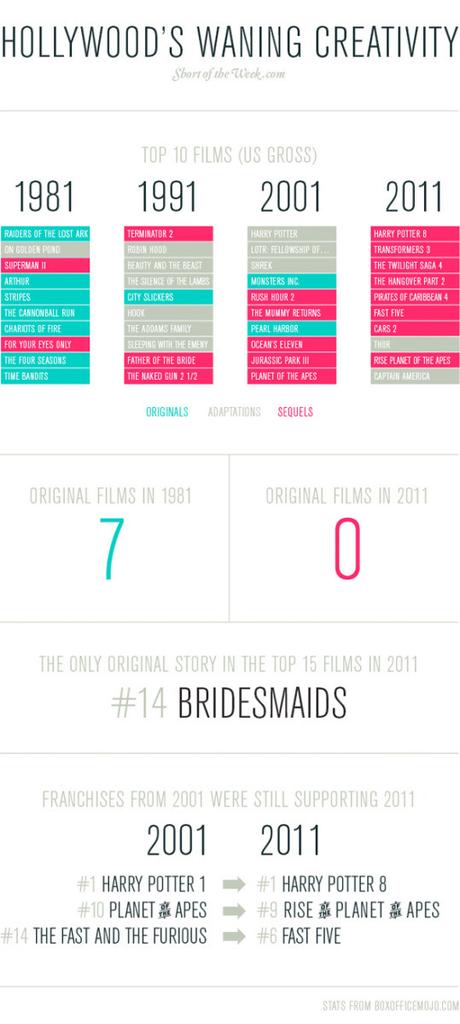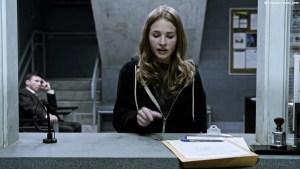How do you spin Tomorrowland’s lack-luster box office into a positive? The Brad Bird-directed action adventure flick starring George Clooney as a cynical inventor tracked down by an optimistic teen (Britt Robertson) in a bid to reach an alternate world called Tomorrowland just had the worst Memorial Day start for a big budget release since Prince of Persia: The Sands of Time in 2010. Across the four-day weekend, Tomorrowland mustered just $41.7m, only slightly better than Prince of Persia’s $37.8m. It’s easily Disney’s biggest miss since The Lone Ranger failed to crack $30m in its 2013 opening. Worse yet, Tomorrowland fared no better overseas, pulling in under $27m from 65 markets. China was supposed to be its last remaining hope, but you can pretty much forget about that since it made less than $3 on its first day in the Middle Kingdom yesterday (compared to the $30.5m Age of Ultron made in China two Tuesdays ago).
In truth, you can’t spin any of that into a positive, not when your film cost $180m to produce and who the heck knows how much to market. The only objectively good thing is that the actual box office totals, which is what I reported above, were slightly better than the studio’s early estimates, but just barely, certainly nowhere near enough to cause analysts to re-evaluate their conclusions that the film will lose money for the studio. So, in speaking to THR, Disney’s distribution chief Dave Hollis mirrored the character Robertson plays in the film by clinging to optimism, “We knew we had an original intellectual property and that it would take a beat for people to find it. And with kids beginning to get out of school, we are in great position.” He sold that same story to Variety, going one further in elevating Tomorrowland into a martyr, “[It’s] an original movie and that’s more of a challenge in this marketplace. We feel it’s incredibly important for us as a company and as an industry to keep telling original stories.”

Now’s probably a good time to post this 4-year-old infograph
Banging the drum for original stories is a little rich coming from a representative of Disney. Once you get to a certain budget level, all they do is adapt Marvel comic books, re-make their classic animated films into live action, and crank out Pirates of the Caribbean sequels. They’re more prone to experiment with original ideas on the Disney Animation Studios and Pixar side of things. Of course, Pixar has Finding Nemo, Toy Story and The Incredibles sequels on the way, but their next film, Inside Out, is an original idea even though the premise (a person’s inner thoughts are played out by multiple characters in their head representing distinct emotions) calls to mind the old Fox sitcom Herman’s Head. Plus, Tomorrowland isn’t even technically an entirely original movie, as Damon Lindelof told BirthMoviesDeath, “The Tomorrowland section of the Disneyland theme parks serves more as an inspiration than as a literal part of our storytelling. In other words, there’s no Space Mountain in our movie. Walt’s futurism, his commitment (and obsession) with building a City of The Future for REAL, was something we were much more interested in capturing. And hopefully, we did.”
However, Hollis’ point about the challenges of launching a seemingly original movie in this market is one of those things that has the ring of, as Stephen Colbert would say, thruthiness to it. It feels true, especially when Warner Bros. also struggled to launch an original sci-fi space opera earlier this year when the world greeted the Wachowski’s Jupiter Ascending with a yawn ($181m worldwide on a $176m budget). In this age in which the viewer has more choices than ever and the international marketplace is more important than domestic, the content makers have become more risk-adverse and prone to favoring known properties which present a higher likelihood of seeing a return on investment. So, there are a lot of sequels, remakes and reboots, both on film and television. Backing a known brand gives you a leg up on creating an audience, as indicated on the TV side of things where Business Insider recently found that the new shows for the upcoming fall season which are generating the most social media buzz are overwhelmingly the ones based on existing franchises. Those creators like Shonda Rhimes on TV or Christopher Nolan in film who persist in making their own original high-profile properties get away with it because they themselves have become known and consistently bankable brands.

Britt Robertson in Tomorrowland
Not everyone’s buying any of that as the specific reason that Tomorrowland failed, though. As FilmSchoolRejects argued, “Tomorrowland’s problem is not that it is too original or too unique or too fresh or too new, but that it failed to leverage those charms—and charms they are—into a feature focused at the precise audience that should be learning to appreciate genuinely new movies right now: kids.” Even Variety’s piece which supported Hollis’ contention about the challenges of opening original movies pointed to some fatal flaws in the Mouse House’s marketing campaign:
Disney may have erred in keeping too many of [Tomorrowland’s] secrets close to the vest. Aside from a magical pin, Clooney as a crusty inventor and a few sequences of spaceships hurtling through what appeared to be a cornfield, it wasn’t always clear what the movie was about. Compounding matters, reviews for the film were lackluster and Clooney’s fans skewed older, missing out on the teenagers Tomorrowland needed to attract to succeed. Adults made up 61% of the opening crowd, something that Hollis admitted surprised him.
Those teenagers flocked to MGM and Fox 2000’s horror reboot of the 1982 classic Poltergeist reboot. It pulled in just under $27m across the holiday, with 60% of its audience under the age of 25. For a modestly budgeted horror film, that’s a solid weekend, and a definite victory for MGM, who moved Poltergiest from its original July 24th release to take advantage of the youth audience Tomorrowland was bizarrely ignoring by making Clooney the selling point of the movie.
To be fair, when I saw Tomorrowland this weekend I did not actually expect Clooney to be the center of the film, and he’s not. The marketing had done enough to make me think I was signing up to see a new actress named Britt Robertson (a 25-year-old playing well below her age and looking quite a bit like Jennifer Lawrence) in a fun action fantasy in which she’s kind of the Marty McFly to Clooney’s Doc Brown. I was actually surprised when the first quarter of the film was a flashback to the childhood of Clooney’s character, marveling at how little I knew about the film’s actual plot beforehand (and how much it grew to remind me of some kind of Disney riff on the SyFy series Eureka).

For the longest time, this scene was one of the only things I’d seen from the movie
It was Brad Bird’s big secret project at Disney for so many years, shrouded in total mystery throughout its production before segueing into a “mystery box” marketing campaign whereby it tried to stand out from the pack by telling us very little. This seems to follow Damon Lindelof around (first on Lost, then on Prometheus and Star Trek Into Darkness), and always eventually backfires.
So, in the absence of concrete story details about Tomorrowland and truly evocative imagery the main appeal of the film turned out to maybe be its vague Disneyland connection and Clooney gloomy’s countenance, which completely misrepresents what the film is truly about. As FSR said, “Brad Bird’s feature is all about wonder, possibility, and progress – basically, it’s got the kind of messaging that is perfect for a younger skewing audience. Although the film is also about combating pessimism and the creation of negative thoughts, Tomorrowland is mainly concerned with the possibilities of the future, particularly as it applies to kids.” So, maybe they should have tried harder to let people know that two of the three main characters in this film are actually young girls (well, in Robertson’s case a woman playing young). As ScreenRant argued:
The characters played by Britt Robertson and Raffey Cassidy in Tomorrowland have received much in the way of praise from critics, so it’s not as though the movie couldn’t have been sold on its merits as a fun adventure featuring two young female heroes – with Clooney’s cantankerous inventor included to sweeten the deal – to help draw in a larger audience. After all, Gravity (an original feature) is easily Clooney’s biggest box office success to date, but the marketing for that Oscar-winning motion picture emphasized Sandra Bullock’s protagonist and the 3D filmmaking over Clooney’s involvement.
Really, Clooney is not much of a box office draw anyway. His biggest hit minus Gravity was nearly 15 years ago (Oceans Eleven), and his last movie to open above $30m (Oceans Thirteen) was 8 years ago. As I discussed when Will Smith’s Focus opened, the idea of a bankable movie star is a fading concept. George Clooney is one of the biggest movie stars in the entire world, just so long as you don’t actually measure that in terms of his ability to put butts into seats.
So, if we’re keeping track, Tomorrowland failed at the box office because:
- “Mystery Box” marketing campaigns backfire sometimes
- George Clooney is not a box office draw
- Disney failed to target the right audience
- Poltergeist proofed to be an unexpectedly successful piece of counter-programming
- Original movies are a tougher sale than franchise properties or remakes/reboots
However, I am reminded of a joke I recently saw on Twitter where someone wished for a time when movies that do well at the box office do so because they’re really good and vice versa for bad movies. It would be nice to simply conclude that Tomorrowland put up box office numbers which are in line with its actual quality as a movie. If it had been better than the type of movie opening night audiences graded as a “B” on CinemaScore and audiences gave a 50% on RottenTomatoes then word of mouth would been stronger throughout the weekend and the numbers would have been higher. But “it’s not as though Hollywood studios haven’t been able to put together great marketing campaigns for so-so films in the past,” and there are plenty of films which no one seems to particularly like which still print cash. Still, the ho-hum critical response and lukewarm word of mouth must have played a part in Tomorrowland‘s box office.
This Memorial Day Weekend’s Actual Box Office Top 10 Totals (5/22-5/25)
1. Tomorrowland (Debut)
- Production Budget=$190m
- 3-Day Weekend Gross (Domestic)=$33m
- 4-Day Weekend Gross (Domestic)=$41.7m
- Weekend Gross (International)=$26.7m
- Worldwide Debut=$68.4m
2. Pitch Perfect 2
- Production Budget=They’re not telling
- 3-Day Weekend Gross (Domestic)=$30.8m
- 4-Day Weekend Gross (Domestic)=$38.5m
- Weekend Gross (International)=$15.2m
- Domestic/International/Worldwide=$126m/$61.7m/$187.7m
3. Mad Max: Fury Road
- Production Budget=$150m
- 3-Day Weekend Gross (Domestic)=$24.6m
- 4-Day Weekend Gross (Domestic)=$32.1m
- Weekend Gross (International)=$38.2m
- Domestic/International/Worldwide=$95.5m/$124.3m/$219.8m
4. Poltergeist (Debut)
- Production Budget=They’re note telling
- 3-Day Weekend Gross (Domestic)=$22.6m
- 4-Day Weekend Gross (Domestic)=$26.5m
- Weekend Gross (International)=$8.3m
- Worldwide Debut=$34.8m
5. Avengers: Age of Ultron
- Production Budget=$250m
- 3-Day Weekend Gross (Domestic)=$21.6m
- 4-Day Weekend Gross (Domestic)=$27.8m
- Weekend Gross (International)=$45.8m
- Domestic/International/Worldwide=$411m/$859.8m/$1.27b
Age of Ultron is now the sixth-highest grossing film of all time, boosted by a 14-day haul north of $200m in China.
6. Hot Pursuit
- Production Budget=$35m
- 3-Day Weekend Gross (Domestic)=$3.6m
- 4-Day Weekend Gross (Domestic)=$4.6m
- Weekend Gross (International)=None
- Domestic Total=$30m
7. Far from the Maddening Crowd
- Production Budget=They’re not telling
- 3-Day Weekend Gross (Domestic)=$2.28m
- 4-Day Weekend Gross (Domestic)=$3m
- Weekend Gross (International)=Less than $1m
- Domestic/International/Worldwide=$6.1m/$9.5m/$15.6m
8. Furious 7
- Production Budget=$190m
- 3-Day Weekend Gross (Domestic)=$2.27m
- 4-Day Weekend Gross (Domestic)=$2.8m
- Weekend Gross (International)=$3m
- Domestic/International/Worldwide=$347.7m/$1.15b/$1.49b
Furious 7 remains the 4th highest-grossing film of all time.
9. Paul Blart: Mall Cop 2
- Production Budget=$30m
- 3-Day Weekend Gross (Domestic)=$1.8m
- 4-Day Weekend Gross (Domestic)=$2.5m
- Weekend Gross (International)=Less than $1m
- Domestic/International/Worldwide=$66.4m/$33.1m/$99.5m
10. Home
- Production Budget=$135m
- 3-Day Weekend Gross (Domestic)=$1.7m
- 4-Day Weekend Gross (Domestic)=$2.4m
- Weekend Gross (International)=$4.4m
- Domestic/International/Worldwide=$168.7m/$192.6m/$361.3m
What Left the Top 10?: Age of Adaline (Current total: $39.8m domestic/$30m budget), Ex Machina (Current total: $21.9m domestic/$1m budget)
What’s Up Next?: Dwayne Johnson’s disaster flick San Andreas and Cameron Crowe’s Bradley Cooper/Emma Stone/Rachel McAdams rom-com Aloha.
Sources: BoxOfficeMojo, FSR, ScreenRant, Variety

